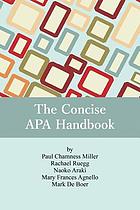
 The Concise APA Handbook
by
The Concise APA Handbook
by
 Publication Manual of the American Psychological Association
by
Publication Manual of the American Psychological Association
by
"APA Style® originated in 1929, when a group of psychologists, anthropologists, and business managers convened and sought to establish a simple set of procedures, or style rules, that would codify the many components of scientific writing to increase the ease of reading comprehension."
(APA Style | "What is APA Style®?")
"APA (American Psychological Association) style is most commonly used to cite sources within the social sciences."
(Purdue OWL | "APA Style Introduction")
APA is also commonly used in education and the sciences (some of which actually have their own specific citation styles). That means, unless your instructor says otherwise, that if you're writing a research paper for your Biology, Business, Chemistry, Criminal Justice, Education, History, Medical Laboratory Science, Psychology, or Sociology classes, then you should probably be citing your sources according to the APA citation style.
APA papers are divided into four major sections.
There are two common types of APA research papers, and both are further divided into sections.
Citing references in-text follow the author-date citation model:
According to APA citation style, you must have a References page at the end of your research paper. All entries on the References page must correspond to the resources that were cited in the main text of your paper.
Entries are listed alphabetically by the author's last name (or the editor's or translator's name) or the title (ignoring initial articles), and the hanging indent style is used. For example:
Berndt, T. J. (2002). Friendship quality and social development. Current Directions in Psychological Science, 11, 7-10.
Merriam-Webster's collegiate dictionary (10th ed.). (1993). Springfield, MA: Merriam-Webster.
Wegener, D. T., & Petty, R. E. (1994). Mood management across affective states: The hedonic contingency hypothesis. Journal of Personality and Social Psychology, 66, 1034-1048.
Feel free to use the following document as a template for properly formatting your paper in APA, but please double-check with your instructor to make sure that you're following his/her specific directions!